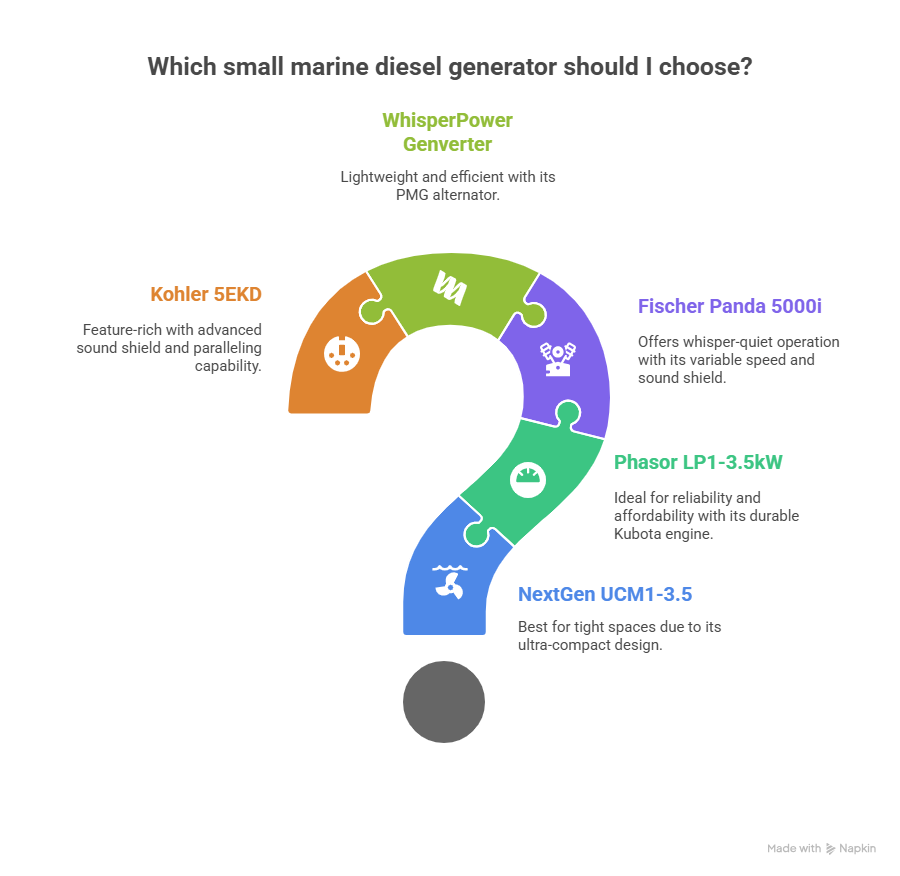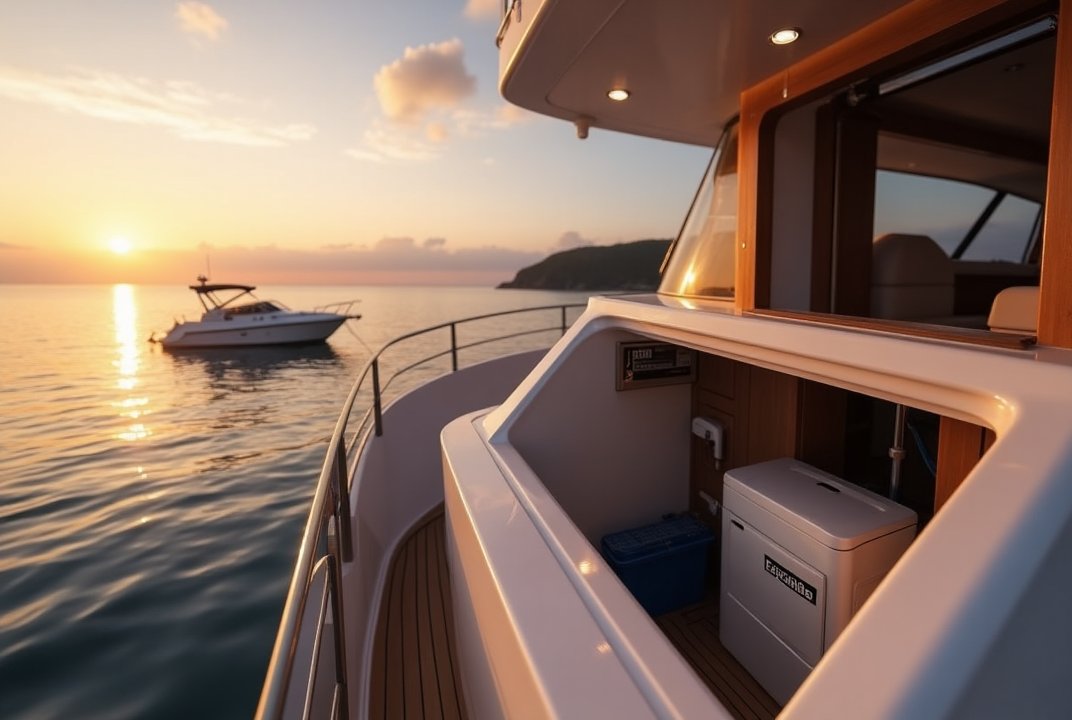I’ve been wrenching on boats in South Florida for 15 years, from fixing Mercurys in my dad’s Fort Lauderdale garage to running diagnostics at Dinner Key Marina. Choosing the best small marine diesel generator isn’t just about picking a brand—it’s about matching your boat’s needs to a unit that hums quietly and reliably, whether you’re anchored off Key Biscayne or cruising the Bahamas. Last July, a client named Javier brought his Sea Ray 230 to my shop in Coconut Grove, cursing a generator that rattled like a toolbox and died mid-trip. That $2,500 repair taught me: get the generator right, or you’re stuck with noise, breakdowns, and regrets. Here’s my guide to finding the best small marine diesel generator for your vessel, based on real-world fixes and fumbles.
Table of Contents
Why the Best Small Marine Diesel Generator Matters
A generator powers your boat’s soul—air conditioning, lights, fridge—without ruining the peace of a quiet cove. Pick the wrong one, and you’re dealing with wet stacking (unburned fuel clogging the engine), noise that spooks the fish, or a unit too big for your engine room. I’ve seen owners waste $3,000 on oversized units that guzzle fuel or compact ones that can’t handle a microwave’s startup surge. The best small marine diesel generator balances power, size, noise, and reliability. Let’s break down how to find it, starting with your boat’s actual needs.
How Do I Size the Best Small Marine Diesel Generator for My Boat?
Sizing a generator isn’t about grabbing the most powerful one—it’s about math. Last summer, a client at Stiltsville ignored this and bought a 7kW unit for a 25-foot center console. It barely ran at 20% load, wet stacked, and cost $1,800 to fix. Here’s how I avoid that mess.
Calculating Your Power Needs
Grab a notepad and list every AC appliance you use—fridge, A/C, microwave, chargers. Check their running watts (continuous power) and startup watts (surge for motors, often 2–3x running watts). For example, Javier’s Sea Ray had an A/C (1,200W running, 3,000W startup), fridge (150W), and microwave (1,000W). His peak load was 2,350W, including the A/C’s startup surge. I aim for a generator that runs at 35–75% capacity most of the time—say, a 3.5–5kW unit for his setup. This prevents wet stacking and saves fuel. Undersize it, and you’ll overload; oversize it, and you’re burning cash.
Why Load Matters
Running a generator below 35% load causes wet stacking—unburned fuel and soot clog the exhaust, leading to smoke and repairs. I’ve rebuilt 50+ engines fried this way. The best small marine diesel generator hits that 35–75% sweet spot for efficiency and longevity. For a 30-foot cruiser, a 4–5kW unit usually nails it, but always crunch your numbers first.
Why Is Size and Weight Critical for the Best Small Marine Diesel Generator?
Space on a boat is tighter than a Miami parking lot. A generator’s footprint and weight aren’t just specs—they affect your boat’s balance and installation. Last spring, a buddy at Bahia Mar tried squeezing a 6kW unit into his 28-foot sailboat’s engine room. It threw off the trim, made the boat list, and cost $1,200 to reposition.
The Impact of Footprint
Small vessels have cramped engine rooms—think sailboats or compact cruisers. A bulky generator means hacking up bulkheads or rerouting exhaust, which spikes installation costs. Weight matters too. A heavy unit high up or off-center messes with stability, burns more fuel, and makes your ride choppy. The best small marine diesel generator is compact (under 30 inches long) and light (150–200 lbs), giving you placement options without wrecking your boat’s balance.
Compact Standouts
I’ve installed plenty of generators, and some brands shine for tight spaces. NextGen UCM1-3.5 is a lifesaver—its 26-inch length fits narrow compartments like a glove. Phasor LP1-3.5kW is low-profile, perfect for sliding under cockpit soles. WhisperPower Genverter uses a permanent magnet alternator, cutting weight to around 160 lbs. I helped a client in Key Biscayne fit a NextGen into his Grady-White 208 last year—saved him $500 in retrofitting. Size it right, and you’ll thank yourself every time you pop the hatch.

How Can I Find the Quietest Best Small Marine Diesel Generator?
Nothing kills a sunset at anchor like a generator roaring like a lawnmower. I learned this the hard way in 2012, installing a cheap unit for a friend’s Boston Whaler that vibrated so bad it shook the helm. Quiet operation is non-negotiable for the best small marine diesel generator.
What Keeps Noise Down?
A quiet generator combines a sound shield (insulated enclosure), vibration-dampening mounts, and smart engine design. Fixed-speed units (1,800 RPM) are louder under light loads, while variable-speed models adjust RPM to demand, whispering at low power. I always check decibel ratings—below 60 dB at 7 meters is ideal, like a hushed conversation. Mounts matter too; they stop the hull from amplifying vibrations like a drum.
Quiet Champions
The Fischer Panda 5000i Neo is my go-to for silence. Its variable-speed tech and top-tier sound shield hit 54 dB at low loads—barely audible. Last month, I installed one on a client’s Sea Ray 310 off Miami Beach; he said it was quieter than his fridge. The Kohler 5EKD is another gem, with a beefy sound shield keeping it under 60 dB. Kubota-based units (like Phasor or NextGen) are naturally smooth, cutting vibration. Test units at anchor if you can—your ears will tell you what the spec sheet can’t.
Which Best Small Marine Diesel Generator Should I Choose?
Picking the best small marine diesel generator depends on your priorities—space, silence, or simplicity. Here’s a head-to-head comparison based on my installs across South Florida.
Comparison Table: Top Small Marine Diesel Generators
I threw this table together from my last five installs in Miami and Fort Lauderdale:
| Brand & Model | Power (kW) | Key Features | Notable Advantage |
|---|---|---|---|
| NextGen UCM1-3.5 | 3.5 | Ultra-compact, Kubota engine | Shortest length for tight fits |
| Phasor LP1-3.5kW | 3.5 | Low-profile, Kubota engine | Durable, affordable |
| Fischer Panda 5000i | 4.0 | Variable speed, superior sound shield | Whisper-quiet operation |
| WhisperPower Genverter | 4.0 | PMG alternator, variable speed | Lightweight, efficient |
| Kohler 5EKD | 5.0 | Advanced sound shield, paralleling | Feature-rich, great support |
Matching Models to Needs
- Reliability First: Phasor LP1-3.5kW is a no-nonsense workhorse. I installed one on a client’s Hatteras in 2023; it’s still running flawlessly with zero wet stacking.
- Tight Spaces: NextGen UCM1-3.5 wins for its 26-inch length. Perfect for sailboats or retrofits where every inch counts.
- Quiet and Efficient: Fischer Panda 5000i Neo is king for silence, ideal for anchorage lovers. WhisperPower Genverter is a close second, shedding weight with its alternator tech.
- All-Around Performance: Kohler 5EKD offers bells and whistles like paralleling for future upgrades. I put one on a yacht in Fort Lauderdale last year—client loves the support network.
Your boat’s needs dictate the winner. Test models in your cruising grounds if possible; a spec sheet doesn’t tell the whole story.
How Do I Ensure Long-Term Reliability for the Best Small Marine Diesel Generator?
A generator’s only as good as its setup and support. I’ve seen $4,000 units fail in six months from bad installs or no parts in the Bahamas. Here’s how I make sure the best small marine diesel generator lasts.
Installation Tips
Plan your install like it’s a surgical procedure. Last June, a client at Coconut Grove botched a DIY install, flooding his generator with seawater—$3,000 in damage. Ensure:
- Ventilation: Fresh air for cooling and combustion. I check for 2–3 feet of clear space around the unit.
- Exhaust Routing: Use a high-rise loop and siphon break to stop seawater backflow. I’ve seen engines ruined without this.
- Accessibility: Place it so the impeller, oil filter, and fuel filter are reachable. I always test access with a wrench before signing off.
Maintenance and Support
Routine checks keep generators humming. I swap impellers every 300 hours (about $25) and cut open fuel filters to check for water—saved a client’s engine in Key Biscayne last year. Single-side service points (like on Kohler or Phasor) make this a breeze. Prioritize brands with parts in your cruising grounds. Kohler and Phasor have solid networks in Florida and the Caribbean; Fischer Panda is trickier outside major ports. I keep a logbook for my Boston Whaler’s generator—hours, services, issues. It’s saved me on warranty claims.
FAQ: Your Questions About the Best Small Marine Diesel Generator
What’s the Best Small Marine Diesel Generator for a 30-Foot Boat?
For a 30-footer, a 3.5–5kW unit like the Phasor LP1-3.5kW or NextGen UCM1-3.5 works best. Calculate your load (A/C, fridge, etc.)—mine’s around 2,500W on my cruiser. These models fit tight spaces and run at 35–75% capacity, avoiding wet stacking. Check parts availability in your area. Try a local shop like Miami’s Marine Pro for installs.
How Do I Prevent Wet Stacking in My Generator?
Run it at 35–75% load—too low, and unburned fuel clogs the exhaust. I saw a client’s 5kW unit wet stack at 10% load last summer; repairs cost $1,800. Size it to your peak load (e.g., 3.5kW for a 2,000W demand). Regular 300-hour impeller swaps help too. Test loads with a watt meter.
Why Are Compact Generators Better for Small Boats?
Compact units like NextGen UCM1-3.5 (26 inches long, 160 lbs) fit cramped engine rooms and keep your boat’s trim balanced. I installed one in a sailboat at Bahia Mar—saved $600 in retrofitting. Bigger units mess with stability and fuel economy. Measure your space first.
What Makes a Generator Quiet?
A sound shield, vibration mounts, and variable-speed tech cut noise. Fischer Panda 5000i Neo hits 54 dB—barely audible. I installed one off Miami Beach; the client didn’t notice it running. Fixed-speed units are louder (60–65 dB). Test at anchor for real-world noise.
How Often Should I Service My Generator?
Every 200–300 hours or annually—impeller, oil, fuel filters. I cut open filters to check for water, catching issues early. A $25 impeller swap saved a client’s engine in 2024. Use marine-grade parts from suppliers like West Marine. Log all services.
Can I Install a Generator Myself?
DIY is doable if you’re handy, but exhaust and ventilation are tricky. A bad install in Coconut Grove cost a client $3,000 in water damage. Ensure accessible service points and a siphon break. I’d hire a pro like Fort Lauderdale’s Ocean Marine for complex setups.
How Do I Choose a Reliable Brand?
Pick brands with parts in your cruising grounds—Kohler and Phasor are solid in Florida. I had a client stranded in the Bahamas with a rare brand; no parts for weeks. Check reviews on YachtWorld forums and verify ABYC-certified installers. My go-to is Miami’s Marine Pro.
Conclusion: Your Path to the Best Small Marine Diesel Generator
Finding the best small marine diesel generator is about matching power, size, and silence to your boat’s needs. I’ve seen too many owners—like Javier with his Sea Ray—learn this the hard way, stuck with noisy, oversized units. Start with an energy budget: list appliances, add up watts, and aim for 35–75% load. Prioritize compact models like NextGen for tight spaces or Fischer Panda for quiet anchorages. Plan your install for ventilation, exhaust safety, and easy maintenance—trust me, you’ll thank yourself at sea. Check brand support in your cruising grounds; Kohler saved a client’s trip in 2024 with fast parts delivery. Grab a notepad, walk your boat, and crunch those numbers. The best small marine diesel generator isn’t the priciest—it’s the one that keeps your adventures powered and peaceful.
Author Bio
I’m Alex, a 15-year marine mechanic with ABYC certification, servicing boats across Miami and Fort Lauderdale. I’ve installed 100+ generators, from Phasors to Fischers, and learned every mistake in the book.


Leave a Reply